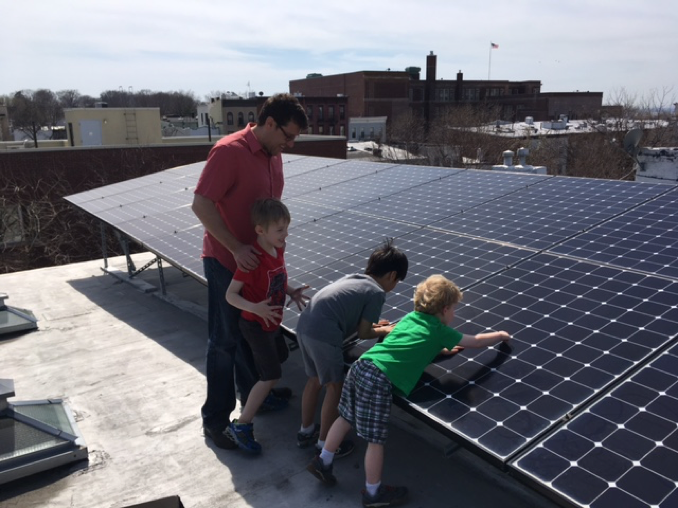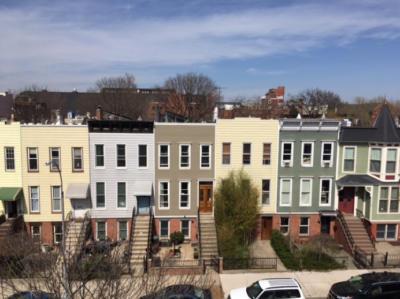Can I borrow a cup of electricity?
Brooklyn neighbors will soon be able to trade power directly — and there’s more to come
Abigail Fagan • July 5, 2017

Brooklyn resident Garry Golden explains to his kids how their solar panels will soon distribute electricity around the neighborhood. [Image credit: Abigail Fagan]
Garry Golden logged on to Facebook one spring day in 2015 and checked the private group for his street in the Park Slope section of Brooklyn. One of his neighbors had posted: “Anyone interested in community solar panels?” Golden’s answer was a resounding yes. He began to research the process and galvanize support in his close-knit neighborhood.
“We’ve got a kick-ass block party every year,” Golden says. “It’s a tight street.”
In this case, the street that parties together, powers together.
Two years later, eleven households on Windsor Terrace have installed solar panels. Standing on Golden’s roof you can see them resting atop beautiful brownstones and soaking up the afternoon sun. These residents, and many others in Park Slope, Gowanus and Boerum Hill, have signed onto a project called the Brooklyn Microgrid, which will allow residents to trade power directly. Houses with solar panels can sell their excess energy to other local homes and businesses.
Knowing that he’ll soon be able to trade energy with his neighbors, Golden says, “feels fantastic.”
The company behind the Brooklyn Microgrid, LO3 Energy, conducted a brief but successful trial of the digital trading platform in April 2016. Now there are 50 energy producing-households and hundreds of consumers signed up. The company hopes to secure the regulatory approvals it needs to launch power-trading in Brooklyn in the coming months. But that’s just an early step in what it hopes will be a blossoming of energy options for families like the Goldens.
“As we have more solar, more storage, and more new technologies coming on to the market, there are more and more ways for people to participate in the energy sector,” says Scott Kessler, LO3 Energy’s Director of Business Development.
A microgrid is a smaller electric grid that can operate independently from the central grid. There are already 160 microgrids in the United States, and the market is expected to grow 116 percent by 2020, according to a report from GTM Research. That’s still a small percentage of overall electric production in the U.S., but concerns about overtaxed and increasingly vulnerable centralized power grids are expected to fuel their growth for years to come.
Brooklyn Microgrid will actually be a pseudo-microgrid, because it won’t operate independently from the central grid that powers the city, which is generated by a combinations of natural gas, coal and renewable sources. Still, the company will create an energy trading platform for members to trade power.
Microgrids are expensive to create, and the legal landscape of electricity is difficult to maneuver, but microgrids have powerful advantages over the conventional centralized grid and are poised to expand moving forward.
When a centralized grid goes down, it can take a long time to come back online, says Brian Miller, leader of the microgrid team at the National Renewable Energy Laboratory in Colorado. “But if we have microgrids, the microgrids can survive on their own during the time that the workers are fixing the problem, and all in all, it improves quality of life,” Miller says.
Much of the U.S. electric grid was built more than a century ago, and wasn’t designed to support today’s high power demands. When one section breaks, it can black out huge sections of a traditional grid. This makes the country dangerously vulnerable to a cyber attack, like the recent assaults on the Ukrainian grid.
Another vulnerability is extreme weather, like Hurricanes Sandy and Katrina, which can knock out power for days. Severe weather is the top cause of power outages in America, costing between $18 and $33 billion every year, according to the U.S. Department of Energy.
“Our power system is relatively reliable under normal conditions, but mother nature can really wreak havoc on it,” says John Saintcross, who manages smart grid research at New York State Energy Research and Development Authority. Smart grids enable two-way communication between the grid and devices, like a thermostat or electric car, to better manage energy use.
Microgrids also make it easier to capitalize on green, sustainable energy. As renewables like wind and solar continue to increase, a community can take advantage of its local wind turbines and solar arrays to power the region and generate revenue.
“It’s not only about utility, it’s also about increasing the local economy” says Michael Stadler, a microgrid scientist at Lawrence Berkeley National Laboratory. “The electrical engineers, the construction companies, all these companies basically will create more jobs because of all these technologies.”

Eleven households along Windsor Terrace in Brooklyn have installed solar panels.
Despite these advantages, some critical hurdles remain. One is the complex legal landscape. Utilities and companies need time to work out the legal details of each project, as in the case of the Brooklyn Microgrid, and often need approvals from multiple government agencies.
Another challenge is that the technology is still new, so every project is like an experiment, Stadler says. “How can you standardize this approach to make all this cheaper and simpler and faster? This is the first problem. People are just walking in the dark here.”
Microgrids are also expensive. Stadler’s current research project is a military microgrid in California that costs a staggering $13 million. Costs will drop as the field develops, but for now, at least, microgrids are hard to justify on a purely financial basis. If a massive power outage occurs, a microgrid would be vital. But most investors won’t throw cash at an infrastructure with little to no immediate returns may not happen.
“It’s much more challenging to find people that are willing to devote funds and money to pure resilience,” says Miller, of the National Renewable Energy Laboratory. “If I just want more ‘nines’ of reliability, from 99.99 up to 99.999 percent reliability, and it’s going to cost me $2 million, well that’s really hard to justify.”
For now, military bases and hospitals are the primary investors in microgrids — the threat of losing lives in a power outage justifies the steep cost. (Most microgrids on military bases and hospitals are fueled by diesel and natural gas — not all microgrids are powered by renewables.)
The economics for neighborhood microgrids are improving, though, especially as the price of solar panels plummets. Golden’s panels initially cost $33,000. But after an immediate state rebate, and federal and state tax credits over the next five years, the price will effectively fall to $16,000. Golden says that it will take about six years to recoup that cost by selling the surplus energy his panels produce. Additionally, his monthly electric bill dropped from around $60 to $18.05, the minimum fee in order to remain connected to the central grid.
Once the Brooklyn Microgrid’s virtual trading platform is up and running, the idea is that Golden could sell power to a neighbor for more than the centralized utility, Consolidated Edison, would pay him for it, and for less than ConEd would charge the neighbor for the clean energy. So while installing panels was a substantial investment, Golden believes he is poised to profit far into the future.
In addition to the large up-front investment, another challenge is the paperwork, permits, and bureaucratic process. For example, right after Golden’s installation, the New York City Department of Buildings changed the permitting process, and many frustrated neighbors had to resubmit their plans.
But after clearing those hurdles, residents are eager to support local clean energy. Park Slope resident Jackie Weisberg says she’s a future consumer of energy from producers like Golden and is even considering installing panels herself.
“I’m totally interested in environmental issues,” Weisberg says. “For my own self to try and be aware as possible of the energy that I’m using and try to make it more sustainable.”
New York State agrees. One initiative under Governor Andrew Cuomo’s energy strategy is a microgrid competition, launched after four severe storms ravaged New York’s power supply: Irene, Lee, Alfred, and Sandy. “The thinking was, is there a way we can address this with the use of microgrids?” says New York’s Saintcross, who directs the $11 million microgrid competition.
Phase one of the competition provided funding for 83 groups to conduct studies on the feasibility of a local microgrid. Phase two financed 11 winners to move on to the design stage. The phase three winners will be awarded in June 2018, and then be able to physically implement their microgrids.
Golden is inspired by the innovation in the energy sector, and the opportunity to reassess conventional marketplaces. Just as Uber and Airbnb transformed cars and houses into sharable, personal assets, microgrids demonstrate that the same idea is taking root in the energy world.
“What most excites me is the shift in thinking among every day people that they can be pro-sumers, that they can actually own energy-producing assets that they control,” Golden says. “That’s the big leap for me.”
1 Comment
My boyfriend thinks he has a cold sore but it isn’t on the outside of his mouth. It’s more on the line where your lips meet. Would that be considered a cold sore?